Matador Network's Blog, page 515
March 11, 2022
A Trip to the Yucatan Isn’t Complete Without a Taste of the Cherished Melipona Honey

Deep inside the low lying forests of Mexico’s Yucatan Peninsula, workers tend to large apiaries to collect a very special type of honey known as melipona. This rich, syrupy liquid has been a sacred source of food and medicine for the indegenous Maya for millenia. Today, melipona honey production is still steeped in culture. It is also gaining worldwide recognition for not only its superb richness but its health properties as well, including by renowned chefs like René Redzepi of Noma.
These bees, however, have long been under threat of extinction. As the Yucatan’s honey gains fame, beekeepers and honey producers are facing additional challenges from climate change and deforestation. And they’re working hard to preserve and protect this prized natural product.
Honey production in the Yucatan dates back to the Mayans. Honey was collected from wild beehives until the stingless species melipona beecheii was domesticated. For the Maya, honey used in sacred rituals and was a source of sugar as well as medicine. Ailments such as eye infections, respiratory diseases, digestive disorders, and skin diseases were all treated with the native melipona honey.

Photo: Left: Alessandro BanchelliShutterstock Right: Alessandro BanchelliShutterstock
After Spain colonized Mexico, several species of European bees were introduced, and much of the early wild beekeeping traditions were lost. However, in many Mayan communities today, melipona apiculture is still an important part of daily life. The traditions that survived are being passed down to new generations — though many young people are leaving the countryside for growing cities and leaving much of the bee collecting to the older generations.
At the same time, thanks to melipona’s new-found fame overseas, honey production in the Yucatan has seen a dramatic shift from small to large scale production and producers are entering a new world of marketing and sales. Silvia Izel Morán from Balaam Keeb is one producer working hard to promote melipona honey for its incredible quality and flavor while preserving the culture behind it.
Balaam Keeb has a storefront in downtown Mérida and sells a wide range of products, from jars of honey to soaps. The jars are separated by flower types which, aside from the special bees themselves, is what sets the Yucatan’s honey apart.
“The flowers that are here in the peninsula are only in this zone,” Izel Moránn tells me. Native plants like dzidzilche, jabin, guava, tajonal, and san diego make all the difference.
These diverse plants are also the sources of many of the honey’s medicinal properties. Of course, none of these compounds could get into the honey if it weren’t for the hard working bees.

Photo: Mario ChirinosShutterstock
“On average, a bee makes 10 trips a day, and on each trip it visits approximately 100 flowers,” Izel Morán says.
Some companies are making a beeline from honey to producing medicine from other substances created by the bees. Dr. María de los Ángeles Moreno Ojeda of Sanjool produces propolis, a resinous substance produced by the bees that’s said to have antifungal, antiviral, and cancer fighting properties. Propolis is the same substance used by ancient Egyptians to embalm royalty, a practice that says a lot about the world wide importance of apiculture. Although more conclusive scientific research is needed, propolis has been used for thousands of years as a medicine worldwide.
“The trees of the Yucatecan jungle are some of the most efficient in making quality propolis, a resinous substance that is produced by the bees (in our case Apis Mellifera),” Izel Morán says. “The bees use this propolis to protect their beehives.”
Although honey production remains an indispensable cultural and economic activity in the Yucatan, climate change is creating new hurdles.
“The climate affects the plants and flowers, and if bees don’t have enough nectar and pollen they can die,” says Helga Giovannini at Ruta de Miel, a company that makes honey and bee products in Merida.
The Yucatan’s weather and rain pattern have always posed a risk to agriculture. Many people are worried that these unpredictable patterns are getting worse. Izel Morán notes that there wasn’t much rain, and therefore not many flowers, in 2017. The reverse can also be catastrophic. If unseasonably heavy rains occur, the pollen may be stripped off the flowers before the bees can pollinate and create honey.

Photo: Samantha Demangate
In the face of global warming and a shifting workforce, many of the Yucatan’s honey producers are doing everything they can to not only save this cultural resource, but to take it into the future. Because of the high demand for Yucatecan melipona honey and honey products in fine dining, cosmetics, and health industries worldwide, many places are expanding operations. And along with the expansion comes conservation.
Many beekeepers are educating local children, tourists, and local businesses alike, and are raising awareness about the vulnerability of the natural habitat. As a valuable natural product, melipona honey is closely regulated locally and internationally, ensuring that the best quality product comes from this region.
Today, the pride for melipona honey and its incomparable quality is insatiable. Anyone visiting Yucatan state must try this honey and the other products these unique bees create.
Where to shop for melipona honey and honey products in Mérida, Mexico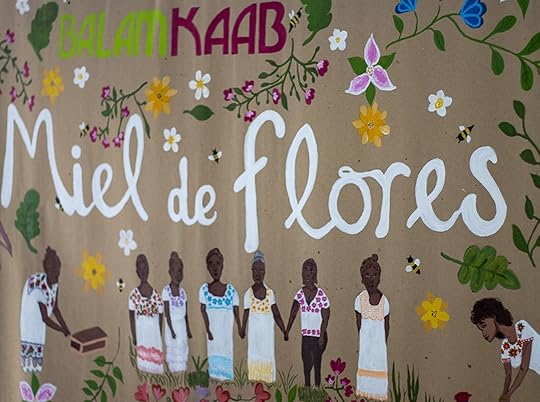
Photo: Samantha Demangate
Balaam Kaab: The storefront is located inside the incredible restaurant Pancho Maiz, where several wonderful products from honey to candles are sold. Contact the business via Facebook or stop in to shop in the beautiful store.
Where: Calle 59 437a, Parque de la Mejorada, Centro, 97000 Mérida, Yuc., México
Sanjool: Sanjool is a family business focusing on the production of propolis from local melipona bees.
Where: C. 48 #472, Brisas del Bosque, 97143 Mérida, Yuc., México
Ruta de Miel: A small group of melipona beekeepers that collects honey one or two times a year, as well showing the bees at schools and public events. Ruta de Miel sells its products, including soaps and mead, on Etsy and in markets and boutique stores around Mérida.
Where: Calle 11, 118, local 4, x 14, García Ginerés, 97070 Mérida, Yuc., México

Stay Near Garden of the Gods and Pikes Peak at These Colorado Springs Airbnbs

At the eastern foot of the Rocky Mountains and sitting at an elevation of 6,035 ft., Colorado Springs is a city filled with historical sites and landmarks — as well as incredible access to the outdoors. Whether you’re visiting downtown, Pikes Peak, Garden of the Gods, or other popular spots, there is always something for you to do as well as somewhere for you to stay. Check out these Airbnb Colorado Springs rentals in popular locations with stunning views, top amenities, and in the heart of all activities.
Airbnbs in downtown Colorado SpringsAirbnb Colorado Springs rentals near Pikes PeakAirbnb Colorado Springs rentals near Cave of the WindsAirbnb Colorado Springs rentals near Garden of the Gods
We hope you love the Airbnb Colorado Springs rentals we recommend! Just so you know, Matador may collect a small commission from the links on this page if you decide to book a stay. Listed prices are accurate as of the time of publication. See our full Advertiser Disclosure here.
Airbnbs in downtown Colorado SpringsCozy architectural hideaway

Photo: Airbnb

Photo: Airbnb

Photo: Airbnb

Photo: Airbnb
Enjoy this fantastic getaway in downtown Colorado Springs. This hideaway is perfect for a couple’s vacation or solo traveler. It has a full kitchen and living room. The home is just a couple of steps away from the downtown core and located in beautiful Shook’s Run, a neighborhood full of charming historic homes within walking distance to dining and nightlife.
Two guests, one bedroom
Price: $184 per night

Photo: Airbnb

Photo: Airbnb
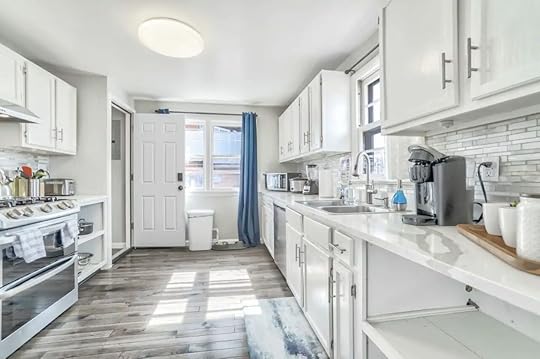
Photo: Airbnb

Photo: Airbnb
This quaint blue and white bungalow is an ideal vacation spot for the whole family, including your four-legged friends. This bungalow has a fully equipped kitchen, spacious living room, and a basement that includes a party room. The party room has a projection tv, shuffleboard table, and a dedicated small kitchen area for entertaining. There is also space out in the backyard for the kids and the dogs to run around.
Twelve guests, five bedrooms
Price: $401 per night

Photo: Airbnb

Photo: Airbnb

Photo: Airbnb
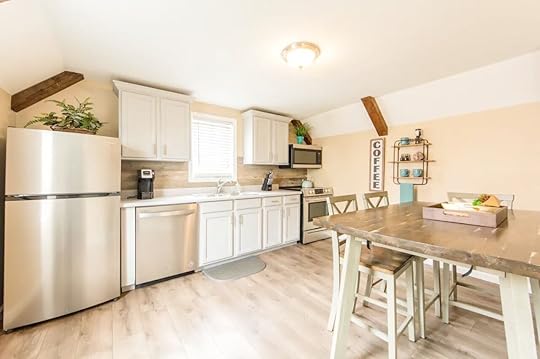
Photo: Airbnb
Located right in the heart of downtown is this urban basecamp that is just a five-minute walk from all of the city center’s activities. This modern one-bed and one-bath space has a full kitchen with all appliances, and a spacious living room is an HD smart TV and a remote-controlled electric fireplace. The place is also a 15-minute drive to Garden of Gods, Cheyenne Canyon, the zoo, and other popular attractions.
Three guests, one bedroom
Price: $111 per night
Airbnbs near Pikes Peak
Chipita Park Place
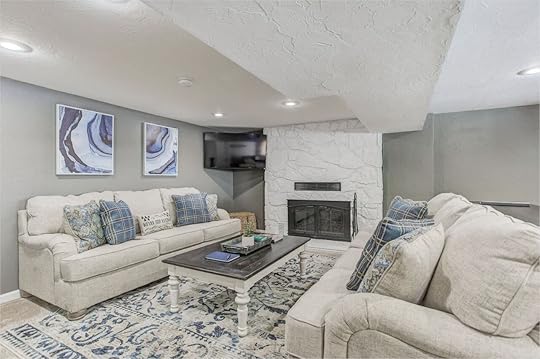
Photo: Airbnb

Photo: Airbnb

Photo: Airbnb

Photo: Airbnb
Check out this private Pikes Peak hideaway. This modern home is located between Green Mountain Falls and historic downtown Manitou Springs (just outside of Colorado Springs) and also sits right along Fountain Creek in the Chipita Park valley and was remodeled back in 2018. With its fully equipped kitchen and large living room, the home also features a private walk-out basement with an open floor plan.
Four guests, one bedroom
Price: $102 per night

Photo: Airbnb

Photo: Airbnb

Photo: Airbnb
This pleasant tiny house is nestled in the Rocky Mountains in the unique mountain town of Woodland Park. This tiny home takes modern french interior and aesthetics to another level with its elegant white interior and its windows that bring in a lot of natural light. There is a full kitchen and living room and a private deck with stunning views of Pikes Peak, and it has garden lights that lead guests to the hot tub.
Two guests, one bedroom
Price: $176 per night

Photo: Airbnb
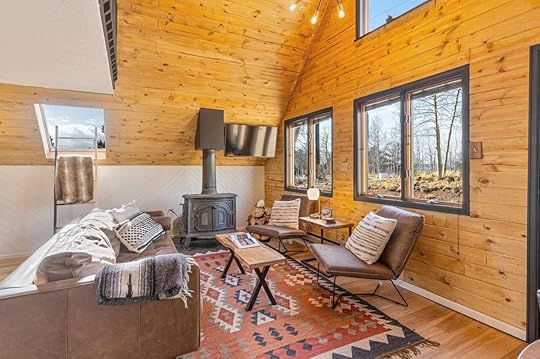
Photo: Airbnb

Photo: Airbnb
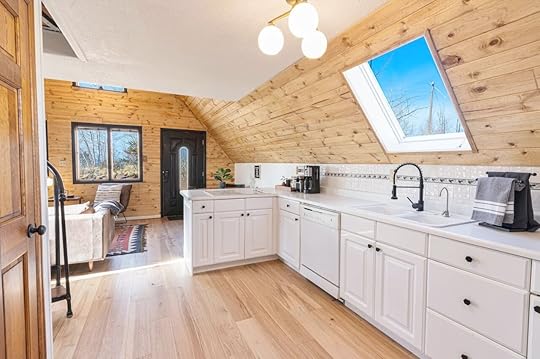
Photo: Airbnb
Immersive yourself with aspens and pine trees and take a break from reality with this secluded A-frame cabin, one of the most unique Airbnb Colorado Springs rentals. This Colorado Springs cabin has everything you need to relax and decompress from the fast pace of city life. The cabin features a full kitchen and a living room with a smart tv, board games, and a speaker for music. There is also a back patio with a propane fire pit, a Weber gas grill, and a picnic table for soaking up the Colorado air and taking in the gorgeous views of the mountains.
Six guests, two bedrooms
Price: $169 per night
Airbnbs near Cave of the Winds
Modern downstairs unit near Historic District of Manitou Springs
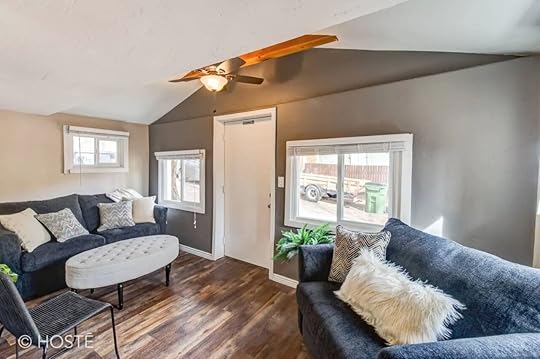
Photo: Airbnb

Photo: Airbnb

Photo: Airbnb
This downstairs unit is the perfect base camp for solo travelers or couples. It’s situated on the hill above historic Manitou Springs. The unit has a kitchen with cooking equipment and a spacious living room. You will be in the Historic District of Manitou Springs, which has incredible art galleries, shops, and restaurants.
Two guests, one bedroom
Price: $311 per night
Little blue house on the creek
Visiting Colorado? Check out our full run-down of the best accommodations across the state:
These gorgeous Summit County Airbnbs are the perfect home for your group ski trip
The six Vail hotels perfect for your upcoming ski getaway
The 12 best Airbnbs in Denver for beer tours, 420, and mountain vibes
10 Airbnb Estes Park area rentals for a beautiful Rocky Mountain National Park stay
Take the stress out of your travel day at one of these Denver airport hotels

Photo: Airbnb

Photo: Airbnb
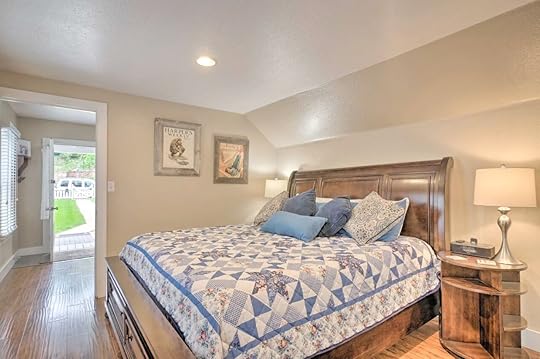
Photo: Airbnb
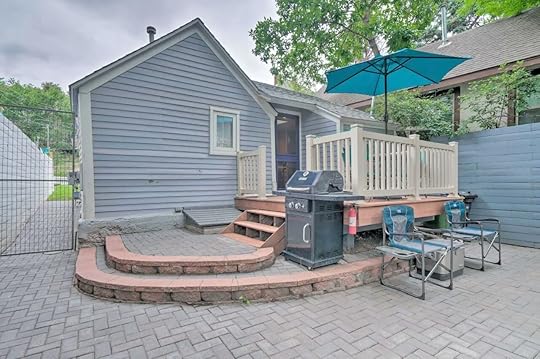
Photo: Airbnb
Check out this lovely and pleasant home that welcomes guests with its inviting vibe. The one-bedroom and one-bath home features a spacious living room and kitchen and a private outdoor area perfect for entertaining. The outdoor area includes a gas grill, al fresco dining, a hammock, and the soothing sounds of the creek that runs in the back of the property.
Four guests, one bedroom
Price: $180 per night

Photo: Airbnb

Photo: Airbnb
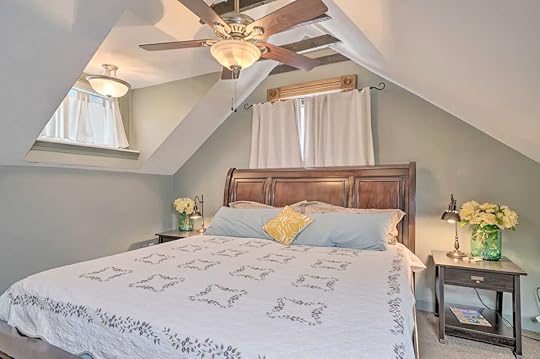
Photo: Airbnb

Photo: Airbnb
Experience this 1,280 square foot home nestled right in the heart of Manitou Springs. This historic home has a fully equipped kitchen, spacious living room, and wraparound deck with stunning mountain views. The home is in the perfect location near downtown Manitou and other amenities.
Six guests, two bedrooms
Price: $171 per night
Airbnbs near Garden of the Gods
Charming cottage with enchanting gardens

Photo: Airbnb

Photo: Airbnb

Photo: Airbnb

Photo: Airbnb
This beautiful Westside property is the perfect stay as it welcomes guests with its warm and stunning color palette that gives off relaxing cottage-like vibes. The friendly cottage is reminiscent of the French countryside. It features a full kitchen and living room and a spacious front yard that showcases the beautiful garden and horses walking by daily with riders.
Five guests, two bedrooms
Price: $149 per night
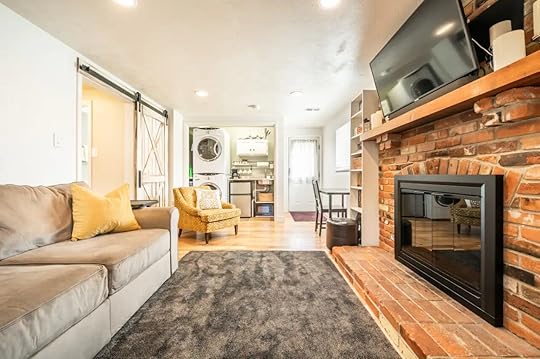
Photo: Airbnb

Photo: Airbnb
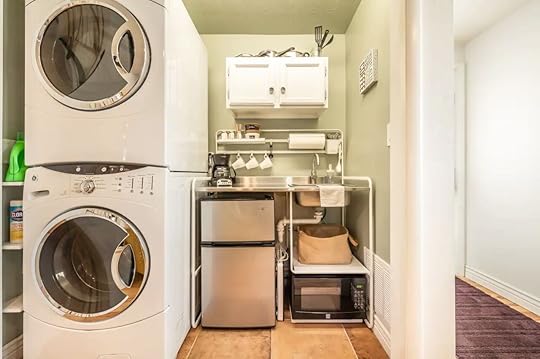
Photo: Airbnb
This cozy guest suite is a few minutes away from Garden of the Gods. It has a kitchenette, spacious open floor plan living room, and stunning views of the mountains. It’s five minutes away from Old Colorado City, blocks away from the historic Rock Ledge Ranch, and minutes away from many other historical sites and landmarks. 
Three guests, two bedrooms
Price: $110 per night
Guide to Daufuskie Island

You might not have ever heard of Daufuskie, an island named after the Muscogee word for “sharp feather” which references its shape. It’s a tiny and quiet community just north of the Georgia/South Carolina border, often overshadowed by the larger and more popular tourist destination of Hilton Head Island. Unlike its northern island neighbor, though, Daufuskie is the dictionary definition of “island life.”
It’s affectionately called the “island with no bridges” since there are, unsurprisingly, no bridges to reach it. This means there are far fewer cars on the island (most visitors and locals drive golf carts) and life is, inherently, paced much slower. Electricity didn’t even come to the island until the 1950s and telephones not until 20 years after that. It is full of abundant wildlife, endless outdoor activities, and eclectic locals who know the true meaning of southern charm.
We hope you love the Airbnbs we recommend! Just so you know, Matador may collect a small commission from the links on this page if you decide to book a stay. Listed prices are accurate as of the time of publication. See our full Advertiser Disclosure here.
Why take a day trip to Daufuskie Island
Photo: Haig Point
The crowded beaches of Hilton Head Island might be too much for some visitors. Life on Daufuskie Island, whether visiting for the day or staying overnight, is quiet and goes on at a snail’s pace. After all, there are only between 200 and 500 permanent residents spread on 5,000 acres.
On top of the laid-back atmosphere and tranquility, there’s also plenty of history, art, and outdoor activities that can satisfy anyone’s tastes. Daufuskie Island has some of the best festivals in South Carolina including a Fourth of July fireworks show that even Hilton Head can’t beat.
How to get to Daufuskie Island: Ferry or water taxi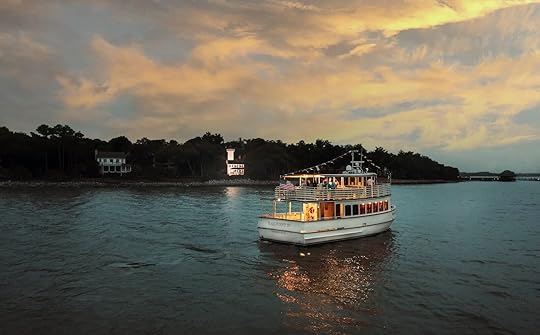
Photo: Haig Point
The Savannah/Hilton Head International Airport is the closest airport to Hilton Head Island (and therefore, Daufuskie) and the easiest place to start your trip if you’re coming from out of town. From the airport, you can rent a car for the most flexibility for your trip or get a taxi or ride-share to the ferries if you’re going straight to Daufuskie. If you’re staying on Hilton Head Island, however, avoid Interstate 95 if possible and take the more scenic route. This allows you to go through the quaint town of Bluffton which is a must-see when visiting this area.
Hilton Head offers a pedestrian ferry boat service (starting at $45 per passenger) that leaves from Buckingham Landing and sails through Calibogue (pronounced KAL-LAH-BOE-GHEE) Sound to Melrose Landing on Daufuskie. It runs four times a day between the two islands except on Fridays when a late-night option is added. Be mindful of the departure times because if you miss the last ferry, you’ll have to wait until the next day to hitch a ride and overnight accommodation isn’t always easy to find at the last minute on Daufuskie Island.
There are other options to get to Daufuskie including taking the scenic water taxi ride from Bluffton with May River Excursions ($150 for a minimum of three people) or the long ride from Savannah out of Bull River Marina ($50 per passenger). If you happen to be staying on Daufuskie at Haig Point Resort, a luxurious Cadillac Escalade will pick you up directly at the airport and transport you to the resort’s private ferry.
How to get around Daufuskie IslandGolf cart rentals on Daufuskie IslandDon’t be fooled by travel websites that advertise Daufuskie as the “island with no cars” because you will see cars. Despite there being no bridges to get to the island, you can bring cars over by freight. It’s expensive and isn’t usually done by visitors.
That said, golf carts are the transportation of choice for almost everyone who lives on and visits Daufuskie. Touring the island by golf cart is the easiest if you are traveling with others, including children. Most of the golf cart rental companies have both four- and six-person options. To rent a golf cart (all starting around $75 for a half-day rental) use Freeport Marina Rentals, Daufuskie Carts, Tour Daufuskie, or Daufuskie Life.
Getting around Daufuskie Island by bikeBikes are a less popular option for both residents and visitors alike. Daufuskie is a small island, but the major attractions are spread throughout its 5,000 acres, so biking isn’t always the most efficient use of your time — especially if you’re only on a day trip to Daufuskie Island. You can rent electric bikes through Fuskie Bike Rentals (starting at $65 for a half-day rental) if you don’t want to save some time and effort. You can even add on a trailer for your four-legged friends. Fuskie Bikes also rents out beach cruisers (starting at $15 for a half-day rental) if you’re looking for an even slower paced option. Or you can always bring your own bike over to the island — most of the ferries will transport them free of charge.
Tours of Daufuskie IslandAnother great way to view the island is by letting others do the work for you. Tour Daufuskie gives comprehensive guided trips with extremely knowledgeable local guides. They have every subject covered from history to art to nature of the local waterways.
Alternatively, you can take the Sallie Ann Gullah History Tour led by Miss Sallie Ann herself! Sallie Ann was born and raised on Daufuskie island and provides a distinct perspective on its history. Plus, it doesn’t hurt that she’s got a lot of personality and spark too!
Things to do on Daufuskie IslandTake a lesson in Indigenous and Gullah historyDaufuskie Island is home to about 200-500 permanent residents. The true number is hard to gauge because many of the houses are summer homes for wealthy people. But where Daufuskie lacks in numbers it makes up for in rich history. Indigenous Peoples called Daufuskie home thousands of years ago prior to European colonization and you can still see the remnants of Native American culture throughout the entire island today.
The Bloody Point Lighthouse (which looks nothing like a typical lighthouse) houses a small museum full of arrowheads and pottery shards from the Indigenous people who inhabited the area long ago. Most recently, in 2021, a longboat was found in the marsh area on the southern side of the island and now sits just outside the lighthouse. If you take the historical tour with Tour Daufuskie (starting at $65 per person), you’ll learn about the battles that gave Bloody Point Lighthouse its name.
After the American Revolutionary War, white settlers tore down trees and built large plantations. The island is generally still split up by plantation border lines. Most locals will tell you where they live by saying what former plantation land their houses reside on. Enslaved people were brought over to Daufuskie Island to work the plantations’ crops of sea island cotton and indigo. The enslaved people were known as Gullah People.
For the best self-guided Gullah history tour, download the map for the Robert Kennedy Trail. This might be the best option for families since you can go at your own pace and take breaks as needed. The tour will take you to 20 historical landmarks on the island and should take you about three-and-a-half hours to complete (if traveling by golf cart). You’ll pass by countless Gullah houses which all have the same layout — a small cottage with one long hallway from the front door and two doors to each side. Many still have doors and windows painted blue to ward off witches and evil spirits as is the Gullah belief.
Tell the tales of Brer Rabbit to the kiddos in your party as you travel the roads. Hopefully they won’t be as clever as the rabbit in these Gullah tales because his wit often got him into trouble. Don’t forget that when you visit the historical places on the map, you need to come out the same door that you went in. The Gullah people believed that it was bad luck to go out a different door.
Patronize the talented artists and artisans of Daufuskie Island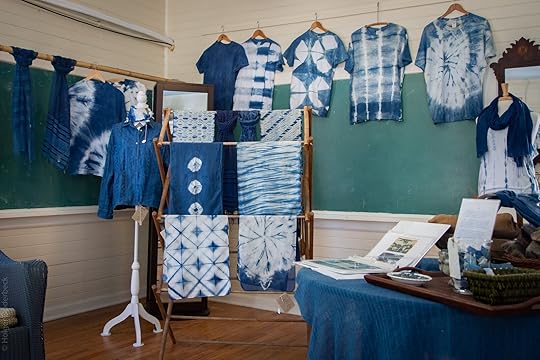
Photo: Haig Point
If you’re an art buff, Daufuskie is filled with artists from every background.
One of the most famous artisans is Chase Allen who handcrafts metal sculptures. His Iron Fish Gallery and Studio on Daufuskie is a must-see. The artist is often in his studio welding new pieces for his gallery.
You can also visit Daufuskie Blues, an indigo-based art gallery. Since 2013, Rhonda and Leanne have been working with the blue dye that has a rich history on the island. Grab yourself a t-shirt, scarf, and more in their small shop housed in the historic Mary Fields School (the first school for Black children on the island).
Lastly, pop by Daufuskie Soap Co. to grab some body scrubs, soaps, and lip balms. Grab a bar of “Islander” soap which smells like coconut, lime, and verbena or a bar of “Nature’s Trail” which has hints of cyclamen flower and amber.
Partake in outdoor activities for adults and children on Daufuskie Island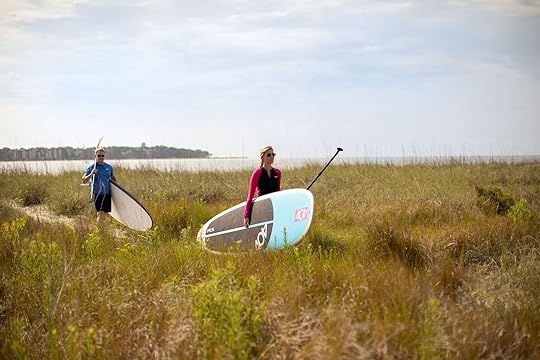
Photo: Haig Point
There are outdoor activities for everyone on Daufuskie Island — even your pickiest of kids.
If you’re raising the next Tiger Woods, you can become a Golf Member for A Day at Haig Point — the only golf course on the island.
Or perhaps you want to take a relaxing horseback ride on the beach. Many of the horses you see at Daufuskie Island Trail Rides (rides starting at $150 per person) are of Iberian horse descent and hardy creatures who love to breathe in the salty air. (when the Spanish settled in the area in the 16th century, they brought over their Iberian breeds). Since those rides are usually people ten years of age or older, smaller kids can always take Nemo for a walk at Haig Point. He’s a miniature horse who doesn’t get enough exercise.
If it’s especially hot, you can also take to the water by kayaking or stand-up-paddle-boarding (rentals start at $80 per day). Take a tour with Outside Daufuskie (starting at $65 per child or $95 per adult) where kids under the age of 12 are welcome (in a tandem kayak).
You can also roam around the Daufuskie Community Farm (tours start at $20 for up to four people) which sits among the shade of the live oaks coated with Spanish moss. It’s a great option for kids who want to pet goats and watch the dozens of chickens that live on the farm.
Turn your day trip to Daufuskie into a wildlife viewing expedition
Photo: Haig Point
Grab your binoculars and bird identification guides when you head over to Daufuskie for the day. You’ll be greeted by dozens of bird species that either call Daufuskie home or use it as a stopover when flying south for the winter. You might even be lucky and run into resident expert birder Mike Loftus (also owner of Daufuskie Wine and Woodworks).
Daufuskie Island is also home to dolphins year-round. The nutrient-rich waters of Calibogue Sound are a healthy ecosystem for dolphins to thrive. On land, you’ll see fox squirrels (which look like lemurs), armadillos, possums, deer, and alligators.
Be a beach bum for a daySandy beaches are an easy way to entertain kids and keep parents relaxed. Luckily, there are several beaches throughout the island. If you’re staying at Haig Point, you are rewarded with pristine beaches that are devoid of tourists. But Daufuskie also has three miles of beaches that are open to the general public. If you don’t want to bring over all your beach accessories, simply select the “Fuskie Beach Package” from Fuskie Bikes which includes two beach chairs, a shade canopy, a cooler with bottled water, and your choice of Bocci or Giant Jenga (starting at $45 for a half-day rental).
The best restaurants on Daufuskie Island
Photo: Haig Point
With Daufuskie Island being as tiny as it is, the food and drinking options are limited. You can grab a quick deli sandwich from D’fuskies Store and Eatery or a nice lunch on the shore at Bells at the Beach (seasonal). If you’re staying at Haig Point, the Calibogue Club has some of the best fine)dining options on the island. If you’re just on the island for the drinks, then head to Daufuskie Island Rum Distillery where they make seven types of rum, one bourbon, and two vodkas.
For the best dining experience, head over to Old Daufuskie Crab Company. If you’re especially lucky, you’ll have Nancy as your bartender. She’s a real sharpshooter who slings drinks and carries on multiple conversations while still making you feel special. Make sure to order a cup of Scrap Iron, the restaurant’s signature drink. It’s a concoction of moonshine and iced tea (along with a bunch of other stuff including a secret ingredient). The drink gets its name after the prohibition era when smugglers would put scraps of metal over the moonshine barrels to trick law enforcement. The restaurant’s patio is perfect for those with kids since the playground is across the dirt path. While you’re sipping your drinks, the kids can play on the tire swings.
Hotels, B&Bs, resorts, and Airbnbs on Daufuskie Island
Photo: Haig Point
Part of Daufuskie Island’s charm is that there are no hotels or B&Bs on the island. But that doesn’t mean you can’t stay overnight. Haig Point is the only resort you can stay at. You can choose between the Strachan Mansion (starting at $500 per night with double occupancy) or the 1873 Lighthouse (starting at $1200 per night based on four-person occupancy). While staying at the resort, you get the added bonus of being able to take advantage of its golf, dining options, and multitude of member benefits.
For much cheaper lodging options, there are various rentals through AirBnB including The Little Red Guesthouse (starting at $197/night) in the historic district; a tiny house called The Indigo Escape (starting at $220/night) which comes with a golf cart rental; or a coastal cottage only 200 yards to the beach. 
The 5 Best Bachelorette Party Destinations for Non-Traditional Brides

As an outdoorsy person currently working to figure out my own bachelorette party, I know that planning a get-together to make everyone happy is harder than it seems. From affordability to availability of accommodations to area activities to car rentals and airports, there’s a lot to figure out.
What complicates the issue even further is that most of the information you’ll find on the best bachelorette party destinations is focused on traditional activities — heading to bars, getting massages, or dressing up in matching t-shirts and pink sashes to go wine tasting. And while I certainly enjoy wine tasting, I’d rather stay home than wear cliché pink t-shirts or do tequila shots at 11 AM. That’s why I’m looking at the best bachelorette party destinations for alternative, older, or more low-key brides.
The destinations below are some of the most unique and fun places in the US you can gather your ladies (or guys) for a weekend of fun. And while you probably won’t run into too many other bachelorette parties while you’re there, they do all have a few factors in common:
They’re all close to an airport: If, like me, you have attendees flying out for the weekend from across the country, you want to make it as easy on them as possible. All these destinations are relatively close to an airport, so no one has to rent a car or take a long trip once they land to reach the party.
They all offer a range of lodging options: Whether you want to camp, stay in an Airbnb, or spring for a posh hotel, you’ll find a wide range of nearby lodging options for you and your crew.
They all offer something different: Most of these places have bars where you can stay out late, but they also offer something unexpected, outdoorsy, or new for your group.
If you’re also not super keen on an urban, nightlife-filled soiree, check out these five best bachelorette party destinations below for brides looking for something a little different.
1. Portland, OR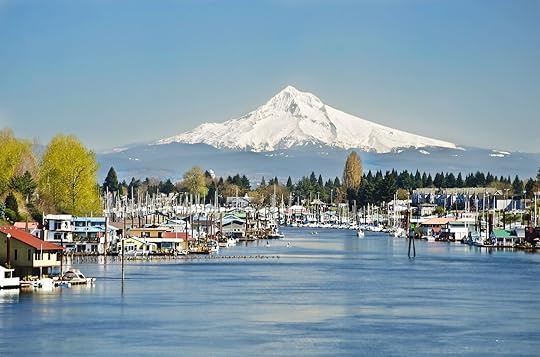
Photo: tusharkoley/Shutterstock
Closest airport: Portland International Airport (0 miles)Probably the most urban destination on this list is Portland, but if you’ve been there, you know it’s not exactly a mainstream city. It feels smaller and more walkable than most comparable cities. To the south is the Willamette Valley wine region, where groups can take e-bike or hiking winery tours. It’s also only about 90 minutes to Tillamook (yes, home of the Tillamook cheese factory), a cute coastal town with great seafood, pretty PNW beaches, and an open-air train sightseeing tour. And if you really want to stretch your legs, Portland is also just 30 minutes from the Columbia River Gorge, a waterfall-laden natural area packed with lush cliffside trails and fabulous views of the Columbia River. You can also sail or paddle in the area.
But if food is more your focus, you’re in luck, too. Portland is home to an H.P. Lovecraft-themed bar called the Coffin Club, several tiki bars, and a bar called Creepy’s, which feels more like a circus sideshow than a dining establishment. And if you’re not a drinker (or even if you are), you may be interested in one of Portland’s other quirky activities, like a private tea tasting, an Indigenous craft-making class, a root- or mushroom-foraging afternoon tour, or even a bakery-to-bakery “Donuts of Portland” bike tour.
2. Juneau, AK
Photo: shorex.koss/Shutterstock
Closest airport: Juneau International Airport (8 miles)You may be surprised to learn that Alaska isn’t as long of a flight as you’d think, especially if you fly into Juneau, which is about a two-hour flight north of Seattle. It’s one of the best bachelorette party destinations if you’re celebrating in summer or fall as it’s basically an outdoor paradise. You can go whale watching on Alaska’s inside passage, take a trek with your crew out to the stunning Mendenhall Glacier, or go on a bear-watching hike.
If you’re up for a more extreme adventure, consider a helicopter dog sledding tour, taking a seaplane to a remote picnic with fresh-caught salmon and wine, or kayaking through the remote Glacier Bay National Park. And if you want to stay closer to town, you could go for a half-day hike through temperate rainforest, have a Prohibition-themed dinner party, or even pan for gold on a history tour. There are far fewer activities available in winter, though if you’re into activities like dog sledding or touring ice caves, you’ll appreciate the low prices and small crowds between October and April.
3. Williamsburg, VA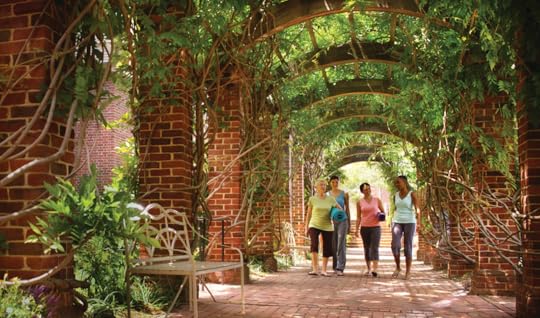
Photo: Visit Williamsburg
Closest airport: Newport News (15 miles) but Richmond and Norfolk (both 45 miles) are much largerThe middle of Virginia may not seem like the most exciting place for a bachelorette party, but it actually has a lot to offer, plus relatively small crowds and affordable pricing.
The main draw for any fun-loving bachelorette party will be Busch Gardens. The park is many steps above your average theme park chain, with a serious commitment to its atmosphere, fabulous indoor and outdoor rides including several roller coasters, live shows and performances, and a massive German-themed “FestHaus,” which carries all manner of German beers. It’s not nearly as crowded as well-known parks like Disney World or Universal Studios and is far cheaper, too. And if you visit in the summer, you may want to spend a day at Water Country, with a massive lazy river and options for renting private cabanas.
What makes Williamsburg one of the best bachelorette party destinations for unique brides is that it has such a wide variety of activities. If theme parks aren’t your thing, head to the Colonial Williamsburg Historic Site for a ghost tour or check out the quirky folk art museum. And if you’re willing to head just a few miles outside of town, you’ll find wineries, riverfront restaurants, and guided horseback riding tours along the James River.
4. St. George, UT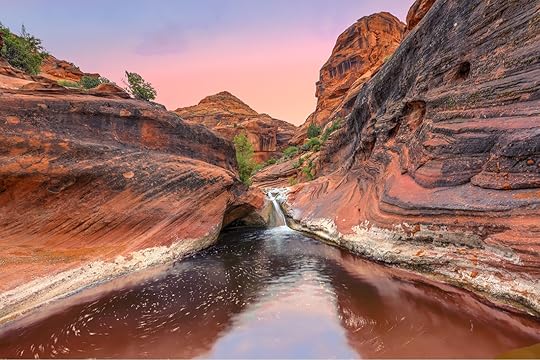
Photo: Mark Bolen/Shutterstock
Closest airport: St. George Regional Airport (15 miles)The town near Zion National Park (Springdale) is a cute little town with fun restaurants and easy access to the park — but it’s usually quite crowded, as is the park itself. So instead, base yourself about an hour down the road in St. George, Utah. You can day trip to Zion National Park — renting e-bikes to ride through the park is a particularly fun group activity — but spend the rest of your time exploring the equally beautiful areas outside the park.
You could head to Snow Canyon State Park to hike through the red rock slot canyons, explore lava tubes, or take a stargazing or (yikes!) scorpion-finding hike. The Above Zion Via Ferrata offers a chance for your group to see an otherwise-inaccessible part of Zion National Park while strapped 1,000-foot-tall cliffs, and St. George offers gorgeous mountain biking, whether you’re a pro or first-time rider. Other options include more traditional bachelorette party activities, like hanging at a glamping resort or hitting a spa.
Food-wise, St. George is surprisingly diverse (and affordable compared to most cities), with options for everything from family-style tapas to Thai to hip pizza joints. St. George is also very close to The Wave, if you can manage to snag a permit for your crew.
5. Monterey County, CA
Photo: SeeMonterey.com
Closest airport: Monterey Regional Airport (3 miles)
If you want the Napa Valley vibes with the addition of coastal breezes and a bit of whale watching, head to Monterey, California. The seaside town is a great place to base yourself for a few days if you want to walk along the famous Old Fisherman’s Wharf, explore the fantastic Monterey Bay Aquarium, or go on a whale-watching boat tour or paddle kayaks with sea lions. The town has excellent restaurants as well as fun group activities like escape rooms and tours of Cannery Row.
But the fact that the greater Monterey County has so many places to go in its borders is what makes it one of the best bachelorette party destinations for outdoorsy brides. Groups can head inland to Salinas and the Monterey County wine region, home to more than 150 wineries. But if you don’t feel like making the drive to a winery, just head a few minutes south of Monterey to Carmel-by-the-Sea, a former artist commune turned into a charming beachside town, complete with “fairytale houses,” dog-friendly beaches, dozens of tasting rooms, arts venues, and enough boutiques and art galleries to fill an afternoon of wandering.
And if you’re willing to drive about an hour, you’ll be at one of the most beautiful places in the entire country: Big Sur. Head out for a day hike in Julia Pfeiffer Burns State Park, have a picnic under the redwoods, enjoy a glass of wine at an outdoor restaurant loved by Jack Kerouac, take a plein air art class, soak in an ocean-view hot spring…the options are (nearly) endless. 
More like thisHumorWhat Bartenders Really Think of Your Bachelorette Party
Our Favorite Carry on Backpacks with Genius Pockets and Compartments

As travel returns it’s a good excuse to upgrade your travel gear, especially if you’re getting back work trips. And trust me, I get it. While getting back in the travel game is exciting and fun, it can also be a complete hassle when you’re not 100 percent organized. While you can’t control a lot of what happens during your flight, at the airport or somewhere in-between, you can control what you have in your bag and how well you’re organized. Here we’ve rounded up the best business travel backpack options that are not only fashionable but also super practical.
We hope you love the backpacks we recommend! Just so you know, Matador may collect a small commission from the links on this page if you decide to purchase. Listed prices are accurate as of the time of publication. See our full Advertiser Disclosure here.
1. Peak Design Everyday Backpack Zip 20L
Photo: Peak Design
While you might know this backpack as a camera gear bag, it’s actually one of the best options for any traveler thanks to its modular design and spacious compartments. Not only can you slide your laptop into a secure, padded compartment, but the whole bag seamlessly slides onto a suitcase. You can customize the entire interior of the backpack to your needs, putting this at the top of our list.
Price: $299
2. Nomatic 30L Travel Bag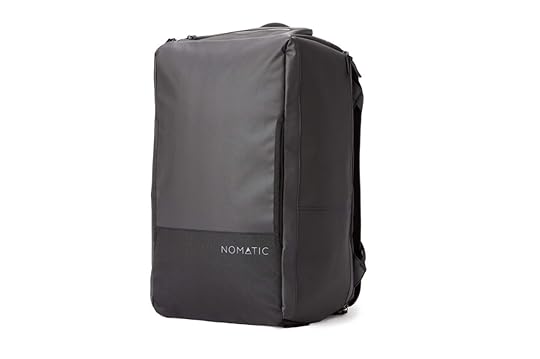
Photo: Nomatic
Nomatic is known for organization and tech and this bag does not disappoint. If you like to travel light, this is a great option as it doubles as a duffle bag and a backpack. Speed through security with the lay-flat laptop sleeve and handy pockets for all your gear and accessories.
Price: $279
3. Solgaard Lifepack Endeavour with closet
Photo: Solgaard
Eco-friendly and efficient as ever, Solgaard’s Lifepack backpack is perfect for the light business traveler. This backpack not only features convenient organization for laptops and other gadgets, but you don’t ever have to pack and unpack on your business trip again. The closet system easily pulls out from the backpack and hangs in any closet. Say goodbye to endless folding and hello to a moveable closet.
Price: $225
4. TUMI Voyageur Uma Laptop Backpack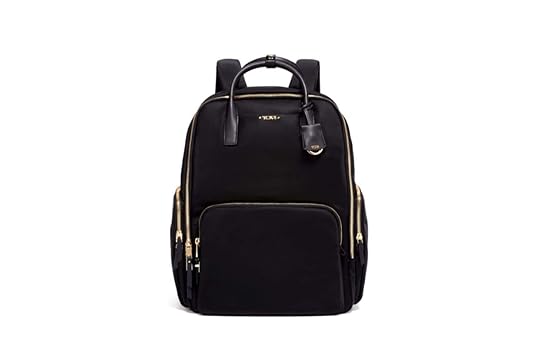
Photo: TUMI
For those of you looking for a little more style, check out the Tumi Uma backpack. This handy little travel bag features easy-access pockets, a padded laptop pouch for up-to 15-inch computers and a convenient sleeve to slide over your suitcase handle. When you deplane, it easily converts to a handbag-style purse so you can head to your meeting in style.
Price: $475
5. Calpak Kaya Laptop Bag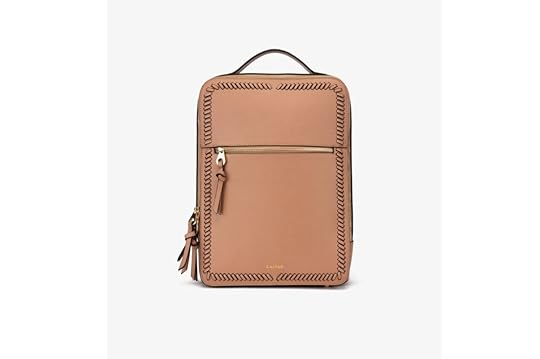
Photo: Calpak
If you’re looking for a high-quality laptop bag that’s stylish and won’t break the bank, look no further than the Calpak Kaya. This beauty features a convenient sleeve for easy storage on your suitcase, a padded laptop pocket and a large sturdy compartment for accessories, clothing and more.
Price: $118
6. Dagne Dover Dakota Neoprene Backpack
Photo: Dagne Dover
This water-resistant, easy-to-clean backpack is perfect for the busy traveler looking for space, flexibility and style. It’s one of the best business travel backpack options because it comes with a shoe bag, a sleeve for easy suitcase handling and a large compartment for up-to 16-inch laptops. This is a great choice for travelers looking for a muted, stylish backpack that’s easy to carry and keep clean.
Price: $200
7. Samsonite Classic Leather Slim Backpack
Photo: Samsonite
If you’re looking for a backpack with some classic elegance, check out the Samsonite Leather Slim Backpack. While it may look old-school on the outside, this backpack features multiple wide compartments for your gear, laptop and more. It has a, dare I say, sexy subtle sleeve to slide over your suitcase and is currently offered at a great price point.
Price: $133
8. TravelPro Maxlite
Photo: Travelpro
TravelPro is one of the most reliable companies in the luggage industry and their bags are known for being lightweight and great for organization. This backpack is ideal for an organized traveler looking for a lightweight option.
Price: $93
9. Cotopaxi Allpa 35 L Travel Pack
Photo: REI
If you’re looking for a bit more color, the Cotopaxi is one of the best business travel backpack options. It’s lightweight, fun and has ample pockets and compartments for your tech, and your gear.
Price: $200
10. Beis Hanging Backpack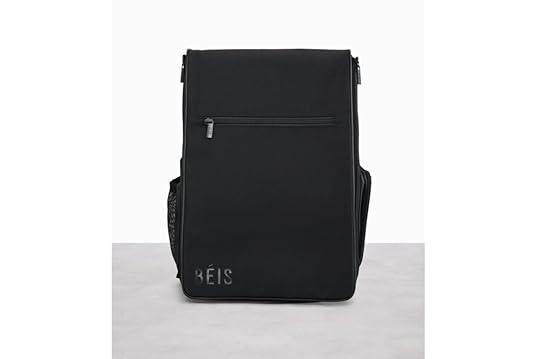
Photo: Beis
Our final favorite is the Beis Hanging Backpack. This all-in-one closet and bag is the perfect business traveler companion, thanks to its convenient, modern design and great functionality. It’s the ideal bag for a lightweight traveler going on a quick business trip. With a convenient suitcase sleeve and laptop compartment, this bag is a must. 
Price: $128
More like thisHikingWhy Hiking in Leggings is Actually DisgustingMarch 10, 2022
Why Flight Attendants Won’t Lift Your Luggage Into the Overhead Bin for You

There’s a myth that for too long has been perpetuated in the air travel industry. While flight attendants are there to assist you throughout your flight, one thing they are actually not supposed to do is lift your luggage into the overhead bin before departure. It might seem like it makes little sense, but there are quite a few reasons. And if you’re vertically challenged or a notorious over-stuffer, this might make things challenging for you. Some people even find the experience of struggling to get your bag in the bin while everyone waits to get behind you kind of awkward.
Trying to lift your heavy carry-on can make a flight attendant susceptible to injuries, Taylor Garland, a representative for the Assn. of Flight Attendants-CWA told the LA Times. An injury on the job means worker’s compensation. If the airline makes this against its policy, it may not cover the injury.
Flight attendants are also not paid for anything they do before a plane is up in the air. And pre-boarding responsibilities are already stressful enough with limited staff. Because of checked baggage fees, more and more people are becoming less inclined to check a bag, which means flight attendants are spending more time making sure bags are correctly stored and if there’s not enough room, check your bag anyway. In the meantime, they are also making sure everyone is properly seated and performing safety checks so that flights take off on time.
So what are your options, besides just checking your bag (which some say is worth the fee regardless)? TikToker Kat Kamalani, a flight attendant for six years, posted her best tips for flying with a carry-on. First, try to lift your luggage over your head at home before your flight. If it’s too heavy, consider leaving some stuff at home. If it’s a brief trip, consider packing even smaller with a pilot’s bag that will fit under the seat. Also, most airlines have placards in the overhead bins that tell you how to put up your luggage. You can also ask your fellow passengers for help. And while a flight attendant may not be able to pick up your bag and put it in the bin for you, they can offer some extra support to assist you.
@katkamalani #stitch with @kaylakayla.1999 that’s facts!!! #travel #tips #askontiktok #CustomersMostLoved ♬ original sound – Kat Kamalani
So the next time you bring a carry-on to fly, do your part to help takeoff go smoothly. 
Explorers of the Modern Age: Gunnar Garfors

Explorers of the Modern Age is a new series by Matador Network spotlighting trailblazers in the world of travel. The world may be less mysterious than it was centuries ago, but the Golden Age of Exploration isn’t quite over yet. There are still new corners of the map to be illuminated, boundaries to be pushed, and travel records to break. These are the adventurers making it happen.
If you’ve read Jules Verne’s Around the World in 80 Days—or seen the ill-conceived movie starring Jackie Chan—you know that Phileas Fogg traveled around the globe in 80 days. That was impressive in 1872 when the story takes place, but in the 21st century, the bar is a lot higher. Author and traveler Gunnar Garfors embarked on his own Vernian adventure that not only dwarfed Fogg’s fictional accomplishment, but set a world record in the process. He circumnavigated the globe in just 56 hours and didn’t stop there. He’s also the first person in the world to travel to every country twice, and visit five continents in a single day.
The embodiment of the modern-day adventurer, Garfors, has taken inspiration from some of history’s most storied explorers, while serving as an inspiration himself to travelers. We spoke to him about how record-setting travel differs from leisure travel, tips for revisiting your favorite destinations, and what the future of exploration looks like.
Why travel to every country twice?It’s an insult to visit a country only once. Coming back gives the possibility to observe changes, meet friends again and perhaps see new places. Having visited before also ensures that you have better knowledge about the place and you are better prepared when it comes to meeting people there and exploring the place.
Does record-setting travel take some of the fun out of travel?The 10 world records I have set do not have much to do about travel, but about logistics. Most people still call them travel world records, but in war, love and world record attempts, everything is allowed. The adrenaline you get when achieving something that no one else has done is exhilarating. I have done most of the records with friends, which makes them into ultimate boy’s trips. I still don’t count world record attempts as travel, because the goal is to set a world record, not to experience certain places. I prefer to take my time when I travel, and be able to explore properly and meet those that live there. World records are super fun, but in very different ways than real travels.
When people ask what you do for a living, how do you explain it while still sounding relatable?Being a travel writer is something that most people can relate well to. Especially since I not only write about far-flung places. My last two books are, for example, about spectacular places beyond the beaten track in Norway. That means that I have traveled “everywhere” in Norway, and that is such an icebreaker when speaking to other Norwegians. When speaking to people from elsewhere, I have visited their country at least twice, know their country, and have stories to tell. That makes it quite easy for most people to relate to me in one way or another.
What’s your advice for visiting the same place a second time? How do you see it with fresh eyes?Challenge yourself to see new places and different parts of the town, region, or country. It is also always good to meet someone local, so reconnect with those you met on previous trips. The locals are always the best experts, and much more knowledgeable, more reliable, and more up to date than guidebooks. Seeing new parts of the country or trying out different restaurants, bars, beaches or hikes than last time is a good way to expand your knowledge of any country. If possible, do also meet someone else than last time, to get new perspectives on the country, its politics, attractions, and challenges.
What would you say to someone who believes there’s nothing left to explore in the world?Arrogance is overrated. It certainly doesn’t help bridge cultures or create friendships either. If traveling doesn’t humble you, nothing will, so perhaps they should travel differently and engage much more with local people from different backgrounds and classes.
Which explorers inspired you?Leif Erikson. He was the first European to visit North America almost 500 years before Columbus. And Fridtjof Nansen who was the first person to cross Greenland and who later did an awful lot of very impressive and rewarding work for refugees.
Do you think 10-20 years from now, there will still be people exploring new, undiscovered places?Yes, but unfortunately primarily for the wrong reasons. Melting ice means that places that have been hidden for thousands of years suddenly reappear, so to speak. There are also still unexplored places in a lot of countries. People do for some reason have a tendency to flock around major attractions, instead of seeking the unique and undiscovered.
What’s one destination you’ve always wanted to visit, but haven’t?I have shamefully still not visited the Hebrides in Scotland. I sure will, though.
We Asked the Pros how to Turn Your Indoor Cat Into an Epic Adventure Cat

Cats have a certain collective reputation for being fastidious groomers, moody, particular about the company they keep, and enjoyers of luxury, relaxation, and sleep. So it may be surprising that adventure cats are at the center of the latest outdoor photography trend. Take a quick look at Instagram and you’ll see that there are about 729,000 posts under the hashtag #adventurecat — i.e., cats who ditched the comfortable cushions and met the great outdoors with the spirit of their wild ancestors.
These so-called adventure cats can do it all. They swim, camp, kayak (in a life vest, of course) hike, go on road trips, and even brave the snow. And they are wildly popular public figures on social media — for example, Reinhardt from British Columbia is a top Instagram adventure cat with 285,000 followers. In addition to being adorable, a second upshot of the growing number of Instagram adventure cats is that there’s now an increased interest in transforming indoor cats into traveling companions.
The idea that all cats will automatically be miserable outside is simply incorrect, says a leading vet. “Cats often get seen as the kind of pet that doesn’t want to go outside but I think we’ve kind of forced them to be that way,” explains Chicago-based veterinarian Dr. Lenyr Muñoz . “A lot of them actually thrive mentally, emotionally, and physically when they get to go outside and feel the wind on their whiskers.”
However, before you can strap a harness on your cat and take her on a hike, you can to follow some guidelines and tactics to ensure your cat is safe and happy. Wannabe adventure cat owners might be eager to capture that perfect shot of their life vest-clad cat at the prow of a kayak like a fearless explorer, but these fickle creatures require months of practice, training, and patience before they can call themselves true adventure cats. Here’s what you need to know (and potentially buy) if you want to train your cat to enjoy the outdoors.
We hope you love the adventure cat gear we recommend! Just so you know, Matador may collect a small commission from the links on this page if you decide to book a stay. Listed prices are accurate as of the time of publication. See our full Advertiser Disclosure here.
Adventure cat training requires patience
Photo: Courtesy Tony Lu
If you’re interested in bringing your cat on your next outdoor excursion, start planning months ahead of time, especially if your cat has never been outside before. If you’re planning on adopting a kitten to eventually become an adventure cat, it’s best to start training right away.
“If you have the ability to start super young, people need to take advantage of that, but that’s not always possible. The key is to take them out every single day, put the harness on them, and go outside,” says Muñoz. “That regular repetition of going out every day is very helpful to get them a little more curious each time.”
Cat owners still need to respect their pet’s temperament and tolerance for the outdoors until they become accustomed to the change in environment. Let your cat take the lead.
“This is not something you want to force a cat to do. If the cat is running or hiding, then use that as your cue to say, ‘I respect this and tomorrow we’ll try again.’”
One way to help your cat get acclimated to the outdoors is by setting up a soft-sided mesh playpen on your porch or in your backyard where your cat can observe and smell the environment while still feeling safe. From there, you can introduce a harness and leash, but be prepared to commit to a months-long process.
Vivian, Toronto-based “cat mom” to Archer, knows from experience that forcing a cat outside before he’s ready doesn’t work. Vivian describes Archer as “very curious and very brave,” but he immediately hid under the couch the first time she opened her backdoor to see if he might be interested in going outside. She put a harness on him when he was about three years old, which inspired him to flop on the ground like a fish and refuse to move. But eventually, he began walking up and down the stairs in his harness and leash. Once he was used to that, she reintroduced the backyard.
“When it comes to training [a cat], sometimes we expect results very quickly, but with a cat, patience is so important,” she says. “We were just very consistent, taking him out every few times a week. It took six or seven months to build up his confidence.”
Lindsey, cat mom to Arizona adventure cat Aries, noticed that he spent all day looking out through her apartment window, which she took as a clue that he wanted to spend more time outdoors. She started the training process by walking him up and down the stairs of their building before venturing onto the patio. But before Aries could even get to the patio, he needed to get used to the harness.
How to train your cat to wear a harness
Photo: Courtesy Tony Lu
A harness is the most important tool in your adventure cat arsenal. Cat owners cannot clip a leash to the cat’s collar — leashes can strain cats’ necks and cause injury. They’re also not as secure around a cat as a dog; cats can easily slip out of collars and bolt into traffic, resulting at best in a scared or lost cat. But cats are infamously intolerant of fabric touching their fur or anything else that might make them feel trapped or constrained, so it takes some training before they become accustomed to the harness.
“We left [the harness] by his food, and he was smelling it and biting it, and playing with it. Then we put it on loosely for ten minutes, gave him a treat, then took it off,” explains Lindsey, who also recommends measuring your cat before purchasing a harness so that you’re sure to buy the right size. “And then we attached the leash [to the harness] and let it drag behind him.”
Lindsey and Aries practiced this routine, gradually introducing him to her backyard and front porch. Six months later, he was ready for his first hike.
Most cats have heightened senses, so the smells of other animals and noises from birds and traffic might be triggering at first. The first time you take your cat on a walk, it should be in a quiet place close to home without distractions like ducks or passing cars. From there, your cat can graduate to more difficult hikes.
“My advice is to observe your cat’s body language, and try to understand how they feel at that moment,” says Vivian. “Your message to your cat when you’re outside is that they can trust you.”
Why every adventure cat needs a backpack
Photo: Courtesy Tony Lu
The second-most important item for any adventure cat is a cat backpack. We love the PetAmi Premium Backpack Dog & Cat Carrier from Chewy, which is both affordable and super durable.
“Cats need to take breaks,” says Vivian, “if it’s too noisy or if they’re in a new environment. They need to have a place where they feel safe. So the backpack is a safe haven for them.”
Vivian says that Archer stays cozy inside the backpack during the winter, especially when there’s snow on the ground, and even rides on top of it sometimes. She finds it especially useful if a dog approaches Archer on the hiking trail.
“I pick him up right away and put him on top of the cat backpack,” she says,” so that there’s distance between him and the dog or the bicycle, or whatever it is that he feels uncomfortable with.”
Lindsey says she finds the cat backpack most useful when Aries gets tired. Usually after about two miles, Aries needs to rest, so Lindsey moves him to the backpack while she keeps hiking.
How to keep your adventure cat safe
Photo: Courtesy Aries Adventure Cat
Before introducing your cat to the outdoors, make sure your cat is current on vaccines and that they’ve been treated for fleas and ticks (topical treatments and pills are available at pet stores).
Vivian coats Archer’s paws with a protective wax before hikes and cleans his sensitive toe pads of rocks, dirt, and other debris after reach hike. She also carries treats and a collapsible water bowl. And she recommends carrying a cat first-aid kit during hikes with, among other items, a pair of tweezers and bandages.
“The other thing I recommend is a dog spray,” adds Lindsey. “It just scares the dog away, but it doesn’t hurt them.”
One more thing to keep in mind: White cats are more susceptible to sunburn, so if you have a white cat you’d like to hike or paddle with, be sure you’ve train your furbuddy to tolerate a sweater or a jacket beforehand as they’ll need the extra protection. Dr. Muñoz also suggests that you equip your adventure cat with a brightly patterned collar birds can spot from far away, signaling to them that your cat is a potential predator.
Lastly, remember that the training process — and ultimately exploring the wonders and beauty of the planet together — can bring you closer to your cat.
“Aries and I have become a lot more bonded and connected,” says Lindsey. “I can read him like a book.” 
5 Tips for Buying the Best Luggage for Air Travel, According to an Airline Employee

When it comes to luggage, you have a lot of choices. And if we’re being honest, mishandling luggage is all too common. So whether you’re a frequent flyer or a first time traveler, it’s important to know if you’ve picked out the best luggage. TikToker Megan Homme, a travel influencer, posted a video explaining her five most important tips for being the perfect suitcase for airline travel.
Tip number one: choose hard-sided or waterproof luggage over soft luggage. Not all plane rides are breeze. Whether your bag is stored as a carry-on or underneath the plane, sometimes liquids spill. And the last thing you want is a huge stain that you’re going to have to clean up.
Tip number two: choose luggage with dark colors. The truth is, as much as we want to believe that our luggage is an airline’s utmost priority, your bag is probably not being carefully placed inside the plane and back out when it arrives at baggage claim. Bags get scuffed up very easily, and a darker colored suitcase is more likely to hide those imperfections.
@meganhomme 3 years working for airlines + nearly 300 flights later #traveltips #travelhack #luggage #traveltiktok #airlinetiktok ♬ Up Beat (Married Life) – Kenyi
Tip number three: get a bag with four wheels vs two. Four wheeled bags are easier to maneuver throughout the airport, and most four-wheeled bags now come with infinity wheels that’ll turn in any direction you want, making it easier to squeeze through tight spaces like airport aisles.
Tip number four: pick out a bag that has an expandable zipper. If you want to overstuff your bag, especially if you refuse to pay for checked luggage fees (though you might want to change your mind on that), an expandable bag gives you full ability to do so. However, Homme said she thinks expandable luggage gives you more liberty to have room to bring souvenirs and other treasures from your trip home.
And finally, tip number five: the most expensive luggage doesn’t have to be the best luggage. So you don’t have to break the bank going designer to find a sturdy great fit.
So the next time you’re in the mood to buy a new suitcase, keep these tips in mind! 
Roll Your Mat and a Joint: this Yoga Studio Wants You to Microdose Before Class

Combine a good yoga studio with talented instructors, and you’ll likely be able to find a class to provide the delightful post-yoga high that comes with stretching your muscles and mind.
But at Flow State Yoga in Banff, Alberta, it’s not a post-yoga high that’s filling classes — it’s the pre-yoga high. And it’s high in the classic sense: the studio wants you to roll a joint before you unroll your mat. Keep it reasonable, though — you still have to be able to stand up straight.
“The goal is to be microdosing so that you feel more uplifted and aware rather than high off your seat,” says Flow State Yoga owner Coleman Rodrigues.
Rodrigues opened the modern one-room yoga studio in downtown Banff in November 2021 and began the popular “Flower with Flow” class just a month later. He says it’s based on something he was already doing in his personal practice and wanted to test the waters to see if others were interested in the experience. While it’s not a requirement, guests are encouraged to come to class high. Cannabis, of course, is the only legal “drug” in British Columbia, but it’s a judgment-free studio. In fact, you don’t even have to come to class high. “It is totally optional to the practitioner,” says Rodrigues, and you will get a benefit from the class regardless if you’re high or not.”
But microdosing is the point of the class, and Rodrigues thinks yoga and cannabis naturally complement each other. “[They] both stimulate the parasympathetic nervous system — the body’s “rest and digest” setting — so combining them together really creates something special,” says Rodrigues. He says that he feels more creative during these classes and finds that his mind can focus more fully on the flow.

Photo: fizkes/Shutterstuck
And if you’re worried that the combination of mary jane and mariayasana (cat pose) may be too much for your body and brain to handle, don’t worry. Classes are slower and more intentional than your average flow yoga class. According to Rodrigues, the class begins with breathwork, followed by a slow flow class and some long-hold poses and finished with an extra-long savasana (corpse pose). It’s not the type of class where you’ll be asked to work on inversions or complicated balancing positions. In fact, it doesn’t really matter if you follow the instructor or not.
“I offer a lot of options for intuitive and slow movement in just about every pose,” says Rodrigues. “The main goal of the class is to really allow people to get out of their head and into their body, pushing them to become curious about movement and how it works within their body.” Creativity is the name of the game, and Rodrigues wants students to note and appreciate how their bodies feel in new positions. To create the “chill, atmospheric” vibes he wants for the class, he usually plays smooth jazz and R&B rather than the usual bansuri or meditative music.
Whether you’re new to yoga or new to microdosing, Rodrigues has you covered. Since the class is slow and gentle, it’s ideal for first-time yogis just starting their practices. And if you’ve never combined yoga and cannabis, he’s got suggestions for that, too. “I would suggest starting with a low dose and finding your edge. My personal recommendation would be a 2.5mg cannabis soda with an equal ratio CBD/THC.”
If you’re planning to visit Banff anytime soon, make your reservation for the Flower with Flow class as far in advance as possible; it’s currently offered Sunday evenings only and is very popular. “It’s been waitlisted almost every week for the past two months,” adds Rodrigues. 
More like thisWinter SportsThe Best Cannabis-Friendly Ski Towns in North America to Visit this Season
Matador Network's Blog
- Matador Network's profile
- 6 followers



